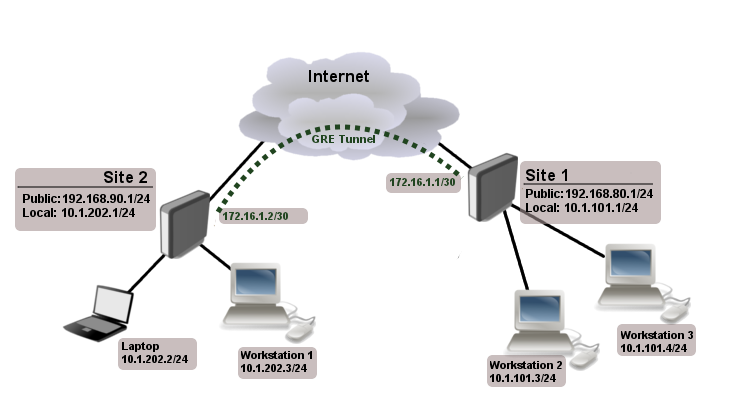Manual:Interface/Gre: Difference between revisions
No edit summary |
m (Removed arp propertie description) |
||
| (2 intermediate revisions by the same user not shown) | |||
| Line 1: | Line 1: | ||
{{Versions|v5+}} | {{Versions|v5+}} | ||
__TOC__ | __TOC__ | ||
==Summary== | ==Summary== | ||
| Line 9: | Line 8: | ||
<br /> | <br /> | ||
GRE ( | GRE (Generic Routing Encapsulation) is a tunnelling protocol that was originally developed by Cisco. It can encapsulate a wide variety of protocols creating a virtual point-to-point link. | ||
GRE the same as [[M:Interface/IPIP | IPIP]] and [[M:Interface/EoIP | EoIP]] were originally developed as stateless tunnels. | GRE is the same as [[M:Interface/IPIP | IPIP]] and [[M:Interface/EoIP | EoIP]] which were originally developed as stateless tunnels. Which means that if the remote end of the tunnel goes down, all traffic that was routed over the tunnels will gets blackholed. To solve this problem, RouterOS have added 'keepalive' feature for GRE tunnels. | ||
GRE tunnel adds 24 byte overhead (4-byte gre header + 20-byte IP header). | GRE tunnel adds a 24 byte overhead (4-byte gre header + 20-byte IP header). | ||
{{Note | | {{Note | GRE tunnel can forward only IP and IPv6 packets (ethernet type 800 and 86dd)}} | ||
==Properties== | ==Properties== | ||
| Line 23: | Line 22: | ||
|prop=Property | |prop=Property | ||
|desc=Description | |desc=Description | ||
}} | }} | ||
| Line 43: | Line 35: | ||
|type=yes {{!}} no | |type=yes {{!}} no | ||
|default=no | |default=no | ||
|desc= | |desc=Enables/disables tunnel. | ||
}} | |||
{{Mr-arg-table | |||
|arg=dscp | |||
|type=inherit {{!}} integer [0-63] | |||
|default= | |||
|desc=Since v5.6, set dscp value in GRE header to a fixed value or inherit from dscp value taken from tunnelled traffic | |||
}} | }} | ||
| Line 64: | Line 63: | ||
|type=IP | |type=IP | ||
|default=0.0.0.0 | |default=0.0.0.0 | ||
|desc= | |desc=IP address that will be used for local tunnel end. If set to 0.0.0.0 then IP address of outgoing interface will be used. | ||
}} | }} | ||
| Line 90: | Line 89: | ||
==Setup examples== | ==Setup examples== | ||
The goal of example is to get Layer 3 connectivity between two remote sites over the internet. | The goal of this example is to get Layer 3 connectivity between two remote sites over the internet. | ||
[[File:site-to-site-gre-example.png]] | [[File:site-to-site-gre-example.png]] | ||
We two sites '''Site1''' with local network range 10.1.101.0/24 and '''Site2''' with local network range 10.1.202.0/24. | We have two sites, '''Site1''' with local network range 10.1.101.0/24 and '''Site2''' with local network range 10.1.202.0/24. | ||
First step is to create GRE tunnels. | First step is to create GRE tunnels. | ||
| Line 129: | Line 128: | ||
</pre> | </pre> | ||
At this point sites have Layer 3 connectivity over GRE tunnel. | At this point both sites have Layer 3 connectivity over GRE tunnel. | ||
{{Cont}} | {{Cont}} | ||
Revision as of 10:52, 21 August 2014
Summary
Sub-menu: /interface gre
Standards: GRE RFC 1701
GRE (Generic Routing Encapsulation) is a tunnelling protocol that was originally developed by Cisco. It can encapsulate a wide variety of protocols creating a virtual point-to-point link.
GRE is the same as IPIP and EoIP which were originally developed as stateless tunnels. Which means that if the remote end of the tunnel goes down, all traffic that was routed over the tunnels will gets blackholed. To solve this problem, RouterOS have added 'keepalive' feature for GRE tunnels.
GRE tunnel adds a 24 byte overhead (4-byte gre header + 20-byte IP header).
Properties
| Property | Description |
|---|---|
| comment (string; Default: ) | Short description of the tunnel. |
| disabled (yes | no; Default: no) | Enables/disables tunnel. |
| dscp (inherit | integer [0-63]; Default: ) | Since v5.6, set dscp value in GRE header to a fixed value or inherit from dscp value taken from tunnelled traffic |
| keepalive (integer [1..4294967295]; Default: ) | Tunnel keepalive timeout in seconds. By default keepalive is disabled. |
| l2mtu (integer [0..65536]; Default: 65535) | Layer2 Maximum transmission unit. |
| local-address (IP; Default: 0.0.0.0) | IP address that will be used for local tunnel end. If set to 0.0.0.0 then IP address of outgoing interface will be used. |
| mtu (integer [0..65536]; Default: 1476) | Layer3 Maximum transmission unit. |
| name (string; Default: ) | Name of the tunnel. |
| remote-address (IP; Default: ) | IP address of remote tunnel end. |
Setup examples
The goal of this example is to get Layer 3 connectivity between two remote sites over the internet.

We have two sites, Site1 with local network range 10.1.101.0/24 and Site2 with local network range 10.1.202.0/24.
First step is to create GRE tunnels. Router on site 1:
/interface gre add name=myGre remote-address=192.168.90.1 local-address=192.168.80.1
Router on site 2:
/interface gre add name=myGre remote-address=192.168.80.1 local-address=192.168.90.1
As you can see tunnel configuration is quite simple.
Note: In this example keepalive is not configured, so tunnel interface will have running flag even if remote tunnel end is not reachable
Now we just need to set up tunnel addresses and proper routing.
Router on site 1:
/ip address add address=172.16.1.1/30 interface=myGre /ip route add dst-address=10.1.202.0/24 gateway=172.16.1.2
Router on site 2:
/ip address add address=172.16.1.2/30 interface=myGre /ip route add dst-address=10.1.101.0/24 gateway=172.16.1.1
At this point both sites have Layer 3 connectivity over GRE tunnel.
[ Top | Back to Content ]